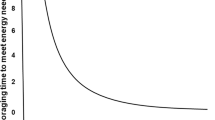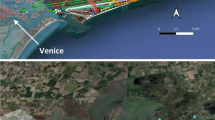Synopsis
The functional analysis of feeding, territory defense and nest-directed activities by reproductively mature male three-spined sticklebacks, Gasterosteus aculeatus, was carried out under controlled laboratory conditions. Territorial males were placed in motivational conflict between feeding and nest-directed activities by making performance of the two necessary activities spatially incompatible. During a limited time each day they had to choose between staying close to their nests to carry out nest-directed activities, and moving into a separate compartment of the observation tank to feed. Males were trapped for varying lengths of time within a central, neutral compartment as they moved between the nest compartment at one end of the tank and the feeding compartment at the other. Their choice of either compartment following such trapping was recorded as indicative of their dominant motivation state. Males tended to be nest dominant in these observations, but motivational dominance could be altered. Males deprived of food for longer periods of time, or presented with an empty food cup during the observation were more likely to be food dominant. If they had not been previously deprived of food, or if a sexually mature conspecific had just been presented in the territory, males were more likely to be nest dominant. The length of time males were trapped in a neutral compartment while in transit between the nest and food also significantly influenced their subsequent behavior. Longer interruptions were more likely to result in a change in the direction in which the male was moving, but only when he was moving towards the subdominant activity. This effect supports the hypothesis of time sharing as the mechanism regulating motivation in these fish.
Similar content being viewed by others
References cited
Coad, B.W. 1981. A bibliography of the sticklebacks (Gasterosteidae: Osteichthyes). Syllogeus 35: 1–142.
Cohen, S. & D.J. McFarland. 1979. Time-sharing as a mechanism for the control of behaviour sequences during courtship of the threespined stickleback (Gasterosteus aculeatus). Anim. Behav. 27: 270–283.
Dawkins, R. 1982. The extended phenotype. W.H. Freeman, San Francisco. 382 pp.
Jenni, D.A. 1972. Effects of conspecifics and vegetation on nest site selection in Gasterosteus aculeatus L. Behaviour 42: 97–118.
McFarland, D.J. 1969. Mechanisms of behavioural disinhibition. Anim. Behav. 17: 238–242.
McFarland, D.J. 1974a. Time-sharing as a behavioural phenomenon. pp. 251–282. In: D. Lehrman et al. (ed.) Advances in the Study of Behavior, Vol. 5, Academic Press, New York.
McFarland, D.J. 1974b. Motivational Control Systems Analysis. Academic Press, New York. 425 pp.
McFarland, D.J. 1983a. Behavioural transitions: a reply to Roper and Crossland (1982). Anim. Behav. 31: 305–307.
McFarland, D.J. 1983b. Time sharing: a reply to Houston (1982). Anim. Behav. 31: 307–308.
McFarland, D.J. 1985. Animal behaviour. Pitman Press, New York. 576 pp.
McFarland, D.J. & I.H. Lloyd. 1973. Time-shared feeding and drinking. Quart. J. Exp. Psychol. 25: 48–61.
McFarland, D.J. & R.M. Sibly. 1975. The behavioural final common path. Phil. Trans. Roy. Soc. B, 270: 265–293.
Ridley, M. & C. Rechten. 1981. Female sticklebacks prefer to spawn with males whose nests contain eggs. Behaviour 76: 152–161.
Sevenster, P. 1961. A causal analysis of a displacement activity (fanning in Gasterosteus aculeatus L.). Behaviour Suppl. 9: 1–170.
Sibly, R.M. & D.J. McFarland. 1976. On the fitness of behaviour sequences. Amer. Nat. 110: 610–617.
Siegel, S. 1956. Nonparametric statistics for behavioural sciences. McGraw-Hill, New York. 276 pp.
Tinbergen, N. 1952. ‘Derived’ activities; their causation, biological significance, origin and emancipation during evolution. Quart. Rev. Biol. 27: 1–32.
Tinbergen, N. 1963. On the aims and methods of ethology. Z. Tierpsychol. 20: 410–433.
Tinbergen, N. & J.J.A. van Iersel. 1947. ‘Displacement reactions’ in the three-spined stickleback. Behaviour 1: 56–63.
van dem Assem, J. 1967. Territory in the three-spined stickleback, Gasterosteus aculeatus L. An experimental study in intra-specific competition. Behaviour Suppl. 16: 1–164.
van Iersel, J.J.A. 1953. An analysis of the parental behaviour of the three-spined stickleback (Gasterosteus aculeatus L.). Behaviour Suppl. 3: 1–159.
Wilz, K.J. 1970a. Causal and functional analysis of dorsal pricking and nest activity in the courtship of the three-spined stickleback, Gasterosteus aculeatus. Anim. Behav. 18: 115–124.
Wilz, K.J. 1970b. The disinhibition interpretation of the ‘displacement’ activities during courtship in the three-spined stickleback, Gasterosteus aculeatus. Anim. Behav. 18: 682–687.
Wootton, R.J. 1976. The biology of sticklebacks. Academic Press, London. 386 pp.
Author information
Authors and Affiliations
Rights and permissions
About this article
Cite this article
Noakes, D.L.G. When to feed: decision making in sticklebacks, Gasterosteus aculeatus . Environ Biol Fish 16, 95–104 (1986). https://doi.org/10.1007/BF00005162
Received:
Accepted:
Issue Date:
DOI: https://doi.org/10.1007/BF00005162




